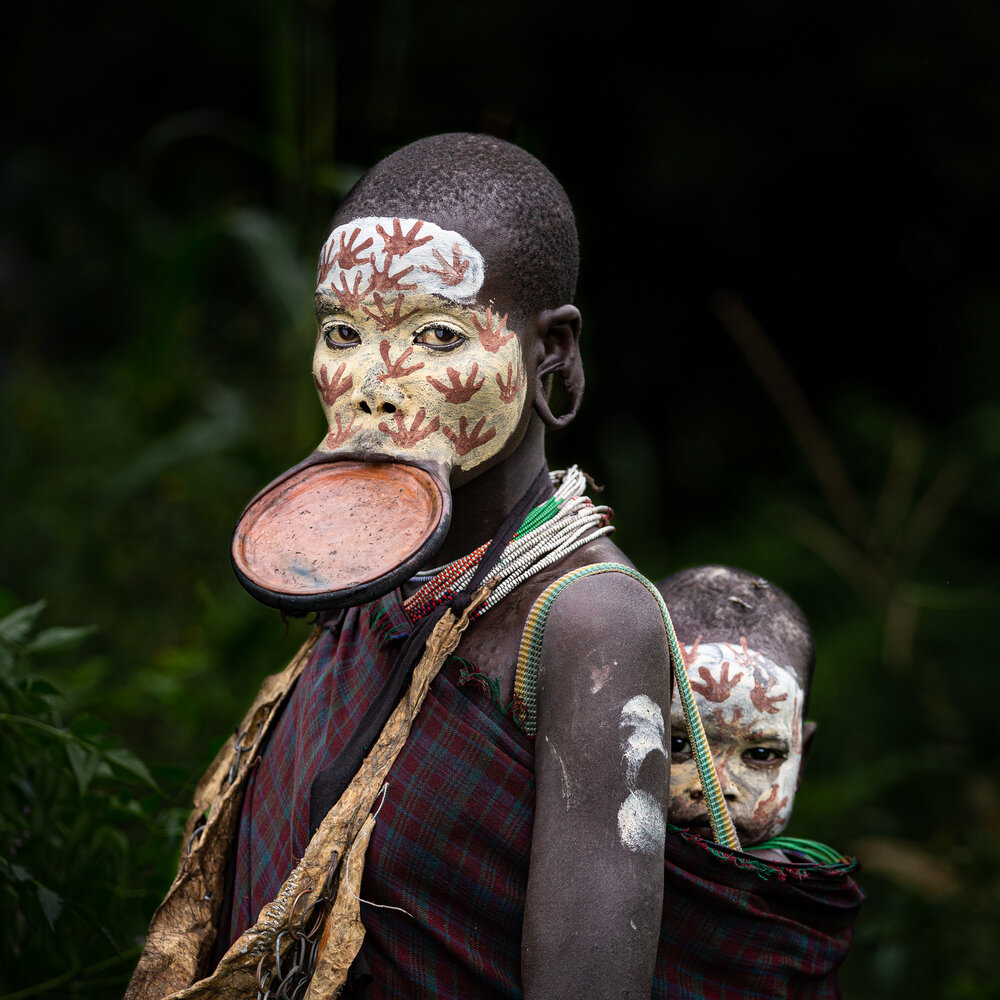In a world where the upcoming generation is dying to follow the Korean beauty standards and trying to look prettier daily, there is a tribe that is breaking all the set rules and norms of beauty.
Where every teenage girl is trying out new glycerin sheet masks or using rice water to wash their face, the tribe is making their girls wear large plates on their lips.
Have you ever heard of tribes Suri and Mursi? If not, let us fill you with some knowledge!

The tribes named Suri and Mursi, the ethnic communities which are collectively known as the ‘Surma Tribe’ still practice the lip plate culture. The tribe hails from Ethiopia, especially from the Omo Valley of Southern Ethiopia.
Factually talking, the Suri Tribe lives in the Upper Omo Valley. Whereas the Mursi Tribe resides in the Lower Omo Valley. And the women of both of these African tribes wear lip plates and follow their traditions.
Why do the tribes still follow the custom?
There are many narrations of the stories related to the tradition of lip plates. Like numerous traditions and cultural history of tribes, the stories were passed on verbally from generation to generation.
From local elders in villages to local guides interpreted different opinions and tales. Considering a few theories on how lip plate tradition begins, it is something that will never be known completely.

Culturally, it is believed that the lip plates were installed to disfigure the girls and women and to make them appear less attractive to slave traders.
But with time the Mursi and Suri Tribe spread the most popular notion and lip plates have become a much loved and wanted symbol of beauty.
As the tribe tell-tales, the lip plate process begins when a girl reaches to age of 15-16 and soon becomes linked to fertility and marking the eligibility to marry.
The bigger the lip plate prettiest the girl will be!
The lip plates actually decide how prettier the girl is! Sounds strange but yes, this is true.
This is weird but men here pay the chosen girls’ father with cattle for marriage and the bigger the lip plate the more cattle it will cost.
Moreover, the larger the plate is the girl is considered the more beautiful one.

The women also understand how much their husbands have paid for their Mursi or Suri Tribe marriage and wear their symbolic lip plate when they serve food to them or in celebrations or ceremonies.
Often, the girls have been promised a man for marriage before they start the lip plate process with the bridal dowry agreed already.
Without any doubt, the men see it as a sign of beauty and the women with lip plates take great pride in the symbolic identity and culture.

Do wooden plates hurt?
The plates are made of wood or clay but mostly with clay. Decorated with a variety of patterns and paints from their local resources, especially the lip plates in the Mursi villages.
But a question is still roaming in my mind: are these plates painful when inserted?
Once the lip has been stretched with a cut to the desired satisfaction, it does not hurt much afterwards. When the girls begin to enter puberty, their mother usually starts the process by inserting a small wooden stick below the lower lip.
Later on the wooden sticks are replaced by bigger sticks or plugs and then clay discs that gradually get bigger to keep stretching the lower lip.
Is this infectious?
During the ongoing procedure the lip can even get infected and it can also break if stretched too quickly.
It is very common in a Surma tribe village to see women who have their lower stretched lip broken with both sections dangling and pointing towards the ground.
While inserting the discs, two or four of the bottom teeth of the young girls are removed in this modification process so the lower lip and mouth can hold the lip plate.

The lip plates are also known as lip discs or lip plugs. In certain processes of getting a lip plate does hurt, but once it’s been created to the desired size, no pain is felt.
Is custom still followed?
The tradition of the tribe is a choice of girl and many young ladies are refusing to continue this custom.
The government have also started putting pressure to stop this, as it can lead to infections which can lead to serious health issues.
The men highly regard the traditional lip plate culture but most seem to respect the decision of the girls.
The change is only a matter of time until there will be no more lip plates in the tribe. Surma people are the last of the tribal groups in Africa, where this is still normal for women to wear lip plates.
The budding generation is choosing to discontinue the lip plate tradition. While, ear plugs and body scarring are some customs that are still practised and are also done for enhancing beauty, style and identity.
The Surma tribe people use razors or branches with thorns for body scarring. Then they rub ash on it so that it raises up and gets highlighted.

The lip plates are not permanent and can be removed while eating or drinking something. Even when women are cooking something or doing chores, they keep their lip plates aside.
The tourists mostly visit the Mursi Tribe as they are closer to reaching the Omo Valley town of Jinka. The tribe lives within the Mago National Park, which touches the border of the Omo National Park.
The Suri Tribe lives in the Upper Omo Valley which is not that far but due to the mountainous terrain and inaccessible roads the Suri people are quite isolated.
The Suri tribe is found near the Kibish town in South West Ethiopia, which is very close to the border of South Sudan.

